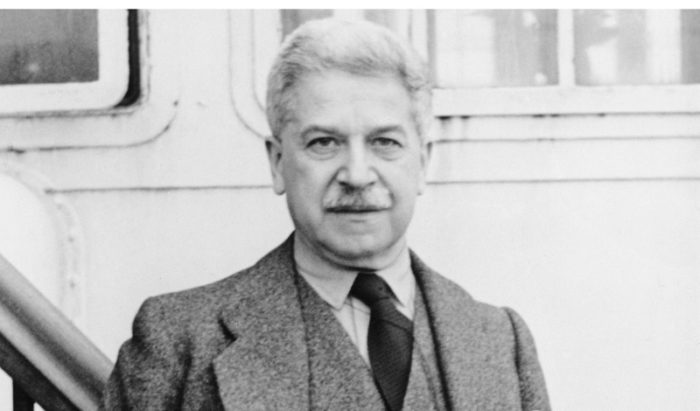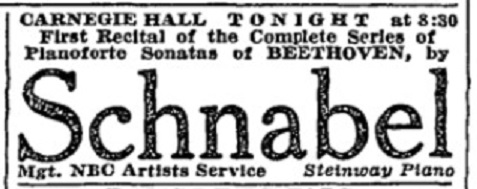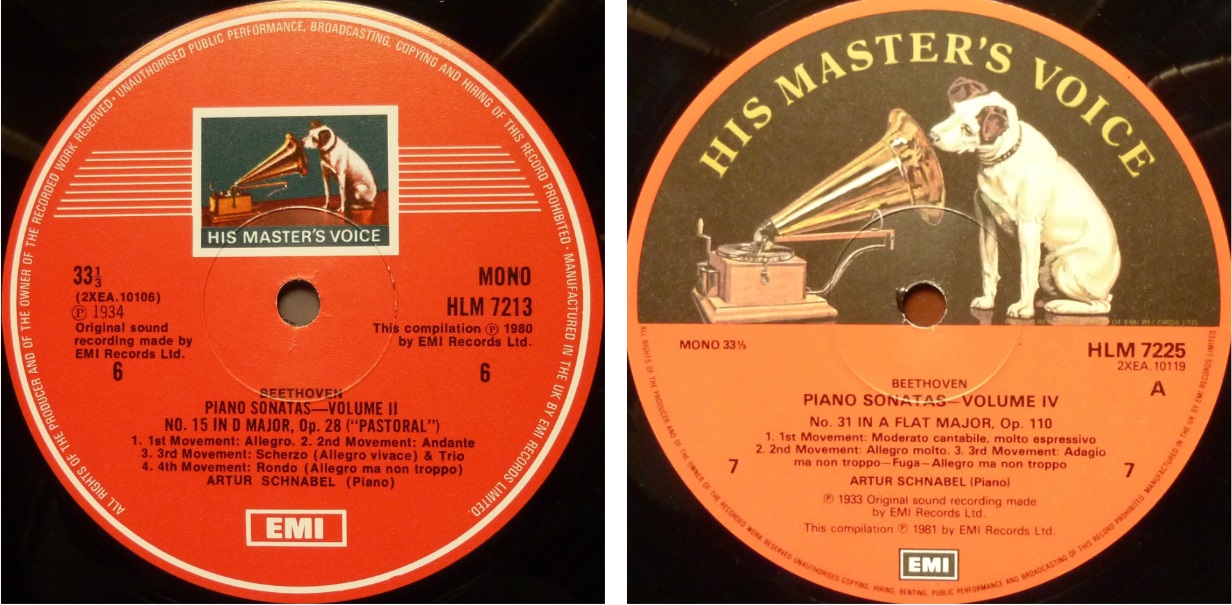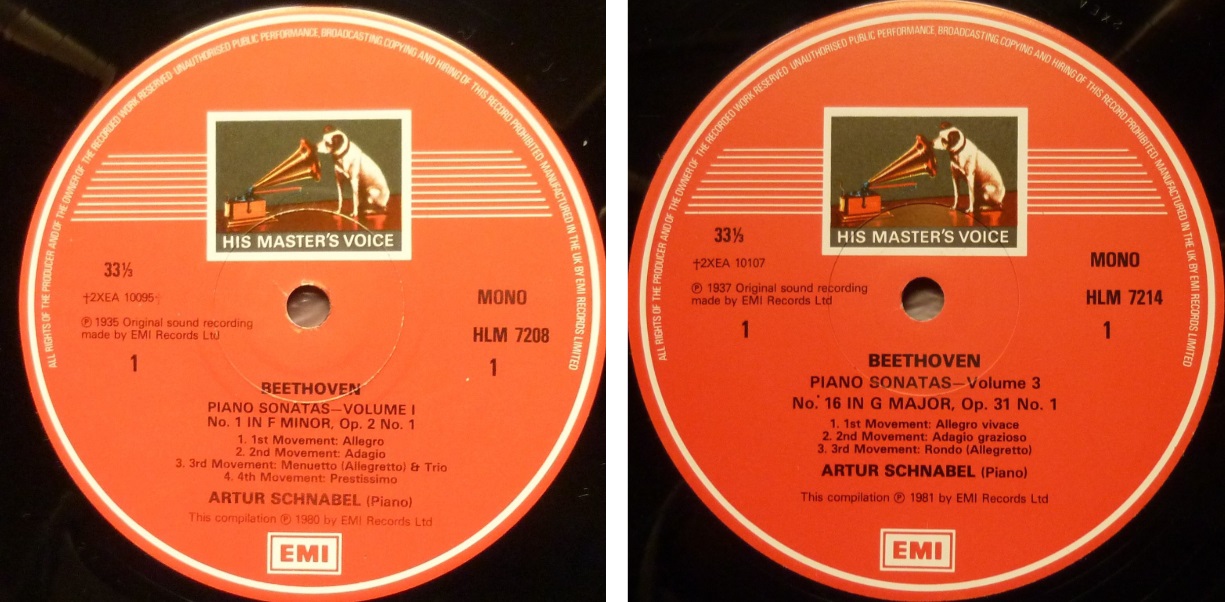
Schnabel – Beethoven Sonates – I/VII – n° 15 Op.28 – n°31 Op.110 – n°1 Op.2 n°1 & n°16 Op.31 n°1
Sonate n° 15 Op.28: 3 & 17 Février 1933
Sonate n°31 Op.110: 21 Janvier 1932 (premier enregistrement de Schnabel)
Sonate n°1 Op.2 n°1: 23, 24 & 28 Avril 1934
Sonate n°16 Op.31 n°1: 5 & 6 Novembre 1935; 15 Janvier 1937 (face 4)
Artur Schnabel, piano
London Abbey Road Studio n° 3 – Engineer: Edward Fowler – piano: Bechstein
Source: disques 33 tours « The HMV Treasury »
Artur Schnabel a non seulement enregistré entre 1932 et 1935 la toute première intégrale des 32 Sonates pour piano de Beethoven, mais, à quatre reprises, il les a aussi jouées au concert à Berlin en janvier-février 1927, à Londres en octobre-novembre 1932, de nouveau à Berlin en janvier-avril 1933 et enfin à New York en janvier-février 1936, sous forme de cycles de sept récitals toujours composés de la même façon, chaque récital panachant soit quatre, soit cinq, sonates de différentes périodes. Pour plus de détails, cliquer ICI
Nous vous proposons d’écouter son intégrale enregistrée en reprenant le programme de chacun de ces sept récitals.
Pour le premier de ces programmes, nous disposons d’une critique tout à fait remarquable, un modèle du genre, écrite par Olin Downes après le récital à Carnegie Hall du 15 janvier 1936:

Downes mentionne tout d’abord que le public était composé en majorité de musiciens, d’étudiants et de mélomanes avertis et que de nombreux spectateurs suivaient attentivement sur la partition. Concernant le pianiste, il mentionne son sens de la grande ligne mais aussi du moindre détail, ainsi que la perfection des proportions, la profondeur de pensée et l’authenticité des sentiments qu’il projette, et enfin la simplicité sans ostentation de sa tenue en scène.
Il souligne que la musique est projetée avec une extraordinaire signification, car chaque sonate, qui est un monde en soi, est traitée comme telle en fonction de la nature de la musique et de la période qu’elle représente dans l’évolution de la pensée Beethoven. Et que cette communication s’établit sans que Schnabel ait jamais besoin « d’élever la voix du piano », car le timbre du piano et la pensée musicale se projettent dans le vaste espace de Carnegie Hall, grâce à une gamme de nuances très finement ajustée. Il note un remarquable degré de différentiation entre des accords « mezzo-piano » et « piano », entre le niveau dynamique de chaque note d’une courte phrase expressive ainsi que des gradations de tempo tout aussi subtiles, comme lors de la dernière apparition du thème dans le mouvement lent de la sonate dite « Pastorale » (n°15 Op.28).
Il note aussi l’objectivité de Schnabel, comme s’il nous disait: « Voici une sonate de Beethoven, et pour autant que j’aie pu le découvrir au cours d’une vie d’étude, c’est comme ceci que Beethoven voulait qu’elle sonne. Je le tiens de la partition de Beethoven que j’ai examinée dans toutes les versions, manuscrites et imprimées et dont ma propre édition énonce mes conclusions« . Ce que décrit ainsi Downes, c’est la filiation de Schnabel, qui composait de la musique atonale, non avec le romantisme, mais avec Arnold Schoenberg.
Concernant le programme joué ce soir là, Downes note de nouveau que chaque sonate y avait son propre style, et que la tranquillité de la sonate n°15 Op.28 qui ouvrait le concert constituait un prélude particulièrement approprié à la rhapsodie démoniaque et mystique de l’Op.110 (n°31), peut-être la plus mystérieuse de tout le cycle, dans laquelle Beethoven rêvait des rêves et avait des visions.
« Quant à la sonate n°1 Op.2 n°1, elle a été jouée avec la pleine prémonition de son caractère prophétique, mais sans exagération. Le mouvement lent a été chanté avec un parfait cantabile et un legato qu’on n’imaginerait pas au clavecin, mais avec une grâce mozartienne et une simplicité dans l’accentuation. Le Finale était plus qu’une prémonition du Beethoven en devenir, et du développement du mouvement romantique de la musique pour piano. Chaque sonate a été saluée par de longs applaudissements. »
La réédition de ces enregistrements a toujours été problématique en raison de l’adoption systématique par les éditeurs d’un filtrage du bruit de fond des 78 tours, qui se fait toujours aux dépens de la musicalité (nuances, phrasés, timbres et dynamique). Toutefois, en 1980/81, à l’occasion du Centenaire de la naissance de Schnabel, une série d’albums 33 tours sous le label « The HMV Treasury » a remarquablement restitué ces interprétations à partir de nouveaux reports effectués par Keith Hardwick dans les Studios d’Abbey Road à partir de pressages vinyle des matrices métalliques d’origine, dépourvus des bruits de surface des disques 78 tours commerciaux. Les éditions successives en CD (EMI et Warner) ont été décevantes à cause de l’usage systématique d‘un filtrage excessif. D’autres éditeurs (Pearl, Naxos) ont obtenu de meilleurs résultats à partir de 78 tours commerciaux, sans toutefois égaler les Albums « The HMV Treasury ».


____________
Sonata n° 15 Op.28: 3 & 17 February 1933
Sonata n°31 Op.110: 21 January 1932 ( Schnabel’s first recording)
Sonata n°1 Op.2 n°1: 23, 24 & 28 April 1934
Sonata n°16 Op.31 n°1: 5 & 6 November 1935; 15 January 1937 (side 4)
London Abbey Road Studio n° 3 – Engineer: Edward Fowler – piano Bechstein
Source: LPs « The HMV Treasury »
Artur Schnabel has not only made between 1932 and 1935 the very first complete recording of the 32 piano Sonatas, but he also performed them four times during concert cycles in Berlin in January-February 1927, in London in October-November 1932, again in Berlin in January-April 1933 and lastly in New York in January-February 1936, each cycle of seven recitals always organized in the same way, each recital being comprised of either four or five Sonatas from different periods. For a detailed description, click HERE
We propose you to listen to his complete recording according to the program of each of these seven recitals.
For the first of these programs, we have an outstanding article, indeed a model, written by Olin Downes after the Carnegie Hall recital of 15 January 1936:

To start with, Downes mentions that the majority of the public consisted of musicians, students and serious music lovers and that a great many in the audience had scores to follow every note of the interpretations. As to the pianist, he notes his sense of the grand line and of the most significant finish of detail, as well as the perfect proportion, the depth of thought and the genuineness of feeling he conveys, but also his unostentasious manner and his simplicity on the platform.
He underlines that the music is projected with extraordinary significance. As each sonata is a different world in itself, so does the treatment of each one vary in accordance with the nature of the music and the period that it represents in Beethoven’s thought. And he establishes this communication never by « raising the piano’s voice », because the tone carries and the musical thought carries in the wide spaces of Carnegie Hall, and this by means of a very finely adjusted scale of values. He notes a remarkable degree of difference between chords « mezzo-piano » and « piano », between the dynamic value of each note of a short expressive phrase, as well as equally subtle gradations of tempo, witness the last appearance of the theme of the slow movement of the so-called « Pastoral »sonata (n°15 Op.28).
He also notes Schnabel’s objective vein, seeming to say: « This is Beethoven‘s sonata, so far as I have been able to discover in a lifetime of study, it is precisely as Beethoven wanted it to sound. My authority is Beethoven’s score which I have examined in all the existing manuscript and printed versions of which my own edition states my conclusions« . What Downes thus describes is the direct line of Schnabel, who composed atonal music, not with romantiscm, but with Arnold Schoenberg.
As to the program performed that evening, Downes notes again that each sonata had its special style, and that the tranquillity of sonata n°15 Op.28 that opened the concert made a particularly felicitious prelude to the demoniac and mystical rhapsody of the Op.110 (n°31), perhaps the most mysterious of the whole set, wherein Beethoven dreamed dreams and had visions.
« The sonata n°1 Op.2 n°1 was performed with the fullest realization of its prophetic character, but without forcing this note. The slow movement was sung with an immaculate cantilena and a legato that it would be hard to conceive as issuing from the harpsichord, yet with a Mozartian grace and simplicity of accent. The Finale was more than a premonition of the Beethoven to come, and indeed of the course of the romantic movement in piano music. There was long applause after each sonata. »
The reissue of these recordings was always problematic because of the systematic use by the editors of noise reduction to filter the background noise of the 78rpm, always detrimental to musicality (details, phrasings, timbres and dynamics). However, in 1980/81, with a view to celebrating the Centenary of Schnabel’s birth, a series of LP Albums under the label « The HMV Treasury » has remarkably restored these performances from fresh transfers made by Keith Hardwick at the Abbey Road Studios from vinyl pressings of the original metal parts, devoid of the background noise of the commercial shellack 78rpm. The later CD issues (EMI et Warner) were a failure because of the systematic use of excessive filtering. Other firms (Pearl, Naxos) obtained better results from commercial shellack pressings, without however matching the « The HMV Treasury » Albums.




5 réponses sur « Schnabel – Beethoven Sonates – I/VII – n° 15 Op.28 – n°31 Op.110 – n°1 Op.2 n°1 & n°16 Op.31 n°1 »
HD/Hi-Res (24 bits/88 KHz):
https://e.pcloud.link/publink/show?code=kZeMYHZmXEGUcH23VQ4OekNWInAdBmJhrxX
Format CD (16 bits/44 KHz):
https://e.pcloud.link/publink/show?code=kZnMYHZwdc70txbTvXrj2CQbsUE7hVyA1DV
Amazing rip! Thank You very much.
Amazing idea to present the sonatas as Schnabel performed them!
Thank you.
Many, many thanks! I own mint, unplayed (so far) copies of these HMV pressings but it is great to have them transferred so expertly in HD!
Being from vinyl pressings of the original metal parts, many of the 78rpm sides have little background noise, and the « HMV Treasury » LPs are mostly very good, so that the transfer isn’t too difficult.
The mystery is why noise reduction was systematically used in the other EMI/Warner reissues, in which we loose much of the details of Schnabel’s playing so well described by Olin Downes, as well as the density and strength of his piano touch.